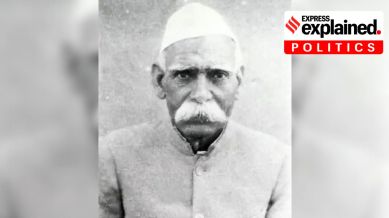Shyamlal Yadav is one of the pioneers of the effective use of RTI for investigative reporting. He is a member of the Investigative Team. His reporting on polluted rivers, foreign travel of public servants, MPs appointing relatives as assistants, fake journals, LIC’s lapsed policies, Honorary doctorates conferred to politicians and officials, Bank officials putting their own money into Jan Dhan accounts and more has made a huge impact. He is member of the International Consortium of Investigative Journalists (ICIJ). He has been part of global investigations like Paradise Papers, Fincen Files, Pandora Papers, Uber Files and Hidden Treasures. After his investigation in March 2023 the Metropolitan Museum of Art, New York returned 16 antiquities to India. Besides investigative work, he keeps writing on social and political issues. ... Read More
Chief Ministers of Bihar | Deep Narayan Singh: the man who was CM for only 18 days
Bihar Politics History, Deep Narayan Singh Bihar CM: Today, we look at Deep Narayan Singh, who came to the chair that fell vacant after the towering Shri Babu's death.

Bihar boasts of one of the most fascinating political histories in India. As it heads to Assembly polls next month, The Indian Express will bring a series of articles that tell the history of Bihar politics through the tenure of its 23 chief ministers. This article, which tells the story of Deep Narayan Singh, Bihar’s second CM, is the second part of the series. You can read the first part here, and you can read the next edition on Binodanand Jha, who fell to factionalism, here.
***
The passing of Anugrah Narayan Sinha in 1957, the second most powerful man in Bihar at the time, strengthened Chief Minister Shri Krishna Sinha’s position. But when S K Sinha, fondly called Shri Babu, himself died on January 31, 1961, less than a year before the state was to head into its third Assembly polls, there was a huge political vacuum in the state.
This was only the second instance in which a Chief Minister had died while in office. In front of then Bihar Governor Dr Zakir Hussain (who later went on to be the President) was thus a formidable challenge: amid multiple rival factions of the Congress jockeying for power, Husain had to decide whether to appoint a new chief minister or recommend President’s rule.
To maintain stability, he chose the former option. Deep Narayan Singh became chief minister. But this was always meant to be only a stop-gap arrangement.
Bihar’s political landscape at the time was vibrant, with luminaries like Dr Rajendra Prasad, who became India’s first President, and Jagjivan Ram, a prominent Union minister. The likes of Krishna Ballabh Sahay, Binodanand Jha, Deep Narayan Singh, Abdul Qaiyum Ansari, Satyendra Narain Singh, Ram Lakhan Singh Yadav, and Abdul Gafoor were also influential.
But in this crowded group, Deep Narayan Singh, was among the most well respected. He held the Ministry of Finance in the Cabinet of the deceased S K Sinha.
Born into a Rajput family in Muzaffarpur, Singh’s journey was remarkable. Initially a school inspector, he abandoned his secure government job to join Mahatma Gandhi’s Civil Disobedience Movement in the 1930s. His political career gained momentum with his election to the Constituent Assembly.
In the inaugural 1952 Bihar Assembly elections post-Independence, Singh secured the Mahanar seat in Muzaffarpur. By the 1957 elections, he had shifted to Hajipur, further consolidating his influence.
A loyal ally of S K Sinha, Singh played a pivotal role in navigating the internal Congress rivalry between Sri Babu and A N Sinha, which predated Independence. His steadfast support ensured S K Sinha’s election as the Congress Legislative Party (CLP) leader in 1952 and 1957, and he bolstered Sri Babu’s camp during elections for the Bihar Pradesh Congress Committee (BPCC) presidency and other decisions of the party and the government.
Following A N Sinha’s death in July 1957, Sri Babu entrusted Singh with the critical Finance Ministry portfolio, recognising his loyalty and administrative acumen.
Singh, the senior-most minister in Sri Babu’s cabinet, took the oath as Bihar Chief Minister on February 1, 1961, but served only until February 18, when the CLP could elect a permanent leader. His tenure lasted a mere 18 days, making it the second-shortest chief ministerial stint in Bihar’s history, surpassed only by Satish Prasad Singh’s five-day term.
Amid intense factionalism within the Congress, Binodanand Jha was elected CLP leader and sworn in as chief minister, effectively side-lining Singh in the Congress.
But his political journey continued. In 1962, he contested and won from Hajipur again. By 1967, he had shifted to the Lalganj constituency, once again securing victory.
But amid Congress factionalism, and Dr Ram Manohar Lohia’s call for non-Congress governments in 1967, Singh looked toward greener pastures to continue his politics. In 1967, he along with some other Congress MLAs, left Congress to form the Loktantrik Congress.
He joined the Cabinet of Chief Minister Mahamaya Prasad Sinha, the first non-Congress CM of Bihar. In 1969 he won from Lalganj on his new party’s ticket.
But demonstrating political pragmatism, he rejoined the Indira Gandhi faction of Congress before the 1972 elections, and reclaimed the Lalganj seat on the old party’s ticket. Amid growing unrest against Indira Gandhi’s central government and Congress’s Bihar government, Deep Narayan Singh, then in his 80s, remained with the Congress.
Singh chose not to contest the 1977 elections, retiring from active politics. He passed away later that year at the age of 83.
His brief tenure as chief minister, though fleeting, underscored his reliability and cemented his place as a significant, if understated, figure in the state’s political history.